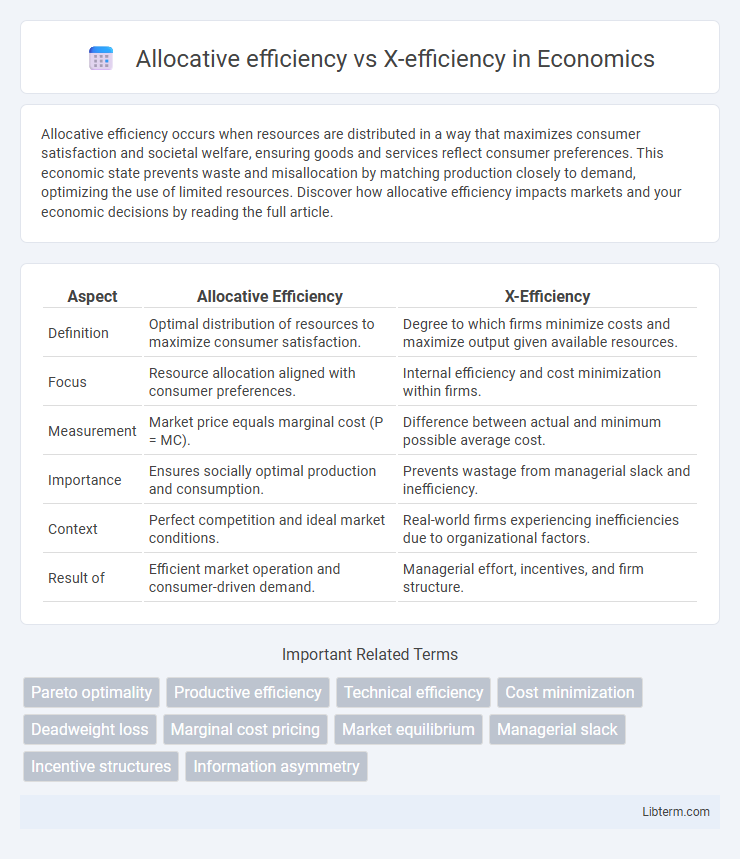Allocative efficiency occurs when resources are distributed in a way that maximizes consumer satisfaction and societal welfare, ensuring goods and services reflect consumer preferences. This economic state prevents waste and misallocation by matching production closely to demand, optimizing the use of limited resources. Discover how allocative efficiency impacts markets and your economic decisions by reading the full article.
Table of Comparison
| Aspect | Allocative Efficiency | X-Efficiency |
|---|---|---|
| Definition | Optimal distribution of resources to maximize consumer satisfaction. | Degree to which firms minimize costs and maximize output given available resources. |
| Focus | Resource allocation aligned with consumer preferences. | Internal efficiency and cost minimization within firms. |
| Measurement | Market price equals marginal cost (P = MC). | Difference between actual and minimum possible average cost. |
| Importance | Ensures socially optimal production and consumption. | Prevents wastage from managerial slack and inefficiency. |
| Context | Perfect competition and ideal market conditions. | Real-world firms experiencing inefficiencies due to organizational factors. |
| Result of | Efficient market operation and consumer-driven demand. | Managerial effort, incentives, and firm structure. |
Introduction to Allocative Efficiency and X-Efficiency
Allocative efficiency occurs when resources are distributed to produce goods and services most desired by consumers, ensuring maximum societal welfare by matching supply with demand. X-efficiency reflects the degree of efficiency maintained within a firm when producing a given output, focusing on minimizing waste and maximizing productivity under real-world conditions. While allocative efficiency emphasizes optimal resource allocation across the economy, X-efficiency highlights internal processes and organizational performance in cost minimization.
Defining Allocative Efficiency
Allocative efficiency occurs when resources are distributed in a way that maximizes consumer satisfaction, ensuring goods and services are produced according to consumer preferences at the lowest cost. It reflects an ideal output mix where marginal benefit equals marginal cost, leading to optimal resource allocation in perfectly competitive markets. In contrast, X-efficiency measures how well firms minimize costs given their resources, focusing on internal operational efficiency rather than the broader market allocation of resources.
Defining X-Efficiency
X-efficiency measures how well firms utilize resources to minimize costs and maximize output given the existing technology and market conditions, focusing on internal operational efficiency. Unlike allocative efficiency, which occurs when resources are distributed to produce the optimal mix of goods and services aligning with consumer preferences, X-efficiency emphasizes the reduction of inefficiencies caused by managerial slack, lack of competition, or suboptimal organizational behavior. Firms exhibiting high X-efficiency operate close to their production frontier, minimizing waste and improving productivity beyond mere market-driven resource allocation.
Key Differences Between Allocative and X-Efficiency
Allocative efficiency occurs when resources are distributed to produce the mix of goods and services most desired by consumers, reflecting optimal resource allocation based on consumer preferences. X-efficiency measures the degree to which firms minimize costs and avoid wastage within existing resources, highlighting operational effectiveness rather than market allocation. Key differences include allocative efficiency's emphasis on market equilibrium and price signals, while X-efficiency centers on internal management performance and cost optimization.
Economic Theories Behind Both Concepts
Allocative efficiency occurs when resources are distributed to maximize consumer satisfaction, reflecting the ideal output mix in perfectly competitive markets based on consumer preferences and marginal costs. X-efficiency, arising from behavioral and organizational economics, highlights the discrepancies in productive efficiency due to factors like managerial motivation, operational slack, and imperfect incentives within firms. Economic theories behind allocative efficiency derive from welfare economics and market equilibrium models, whereas X-efficiency is rooted in principal-agent theory and managerial economics, explaining why firms often operate below the optimal production frontier.
Real-World Examples of Allocative Efficiency
Allocative efficiency occurs when resources are distributed to produce goods and services most desired by consumers, exemplified by competitive markets like Google's AdWords auction, where advertisers bid efficiently based on consumer value. X-efficiency relates to internal productivity and cost minimization within firms, often improving in monopolistic markets pressured by potential competition, such as Boeing's efforts to reduce production costs in aerospace manufacturing. Real-world examples of allocative efficiency include supermarkets adjusting product variety to match consumer preferences and energy markets where prices reflect supply and demand, ensuring optimal resource utilization.
Real-World Examples of X-Efficiency
X-efficiency occurs when firms operate below their potential output due to lack of competitive pressure, often seen in monopolies or government-run enterprises where motivation to minimize costs is weak. Real-world examples include public utilities and state-owned monopolies, such as electricity providers or postal services, where bureaucratic inefficiencies and limited market competition reduce productivity. Allocative efficiency, by contrast, requires resources to be distributed according to consumer preferences, usually achieved in competitive markets, unlike the cost inefficiencies prominent in x-inefficient organizations.
Impacts on Market Performance and Productivity
Allocative efficiency maximizes market performance by ensuring resources are distributed according to consumer preferences, leading to optimal productivity in competitive markets. X-efficiency addresses internal firm performance, focusing on minimizing costs and reducing inefficiencies, which enhances productivity even in less competitive environments. Both concepts impact overall economic output, but allocative efficiency drives value through optimal resource allocation, while X-efficiency improves firm-level cost management and operational performance.
Policy Implications and Efficiency Improvements
Allocative efficiency ensures resources are distributed to maximize consumer satisfaction and welfare, guiding policymakers to design market regulations that align production with demand. X-efficiency focuses on minimizing operational inefficiencies within firms, prompting policies that foster competition and innovation to reduce managerial slack and cost overruns. Emphasizing both allocative and X-efficiency leads to comprehensive efficiency improvements by balancing optimal resource allocation with internal cost control and productivity enhancement.
Conclusion: Importance of Both Efficiencies in Economics
Allocative efficiency ensures resources are distributed to maximize consumer satisfaction, reflecting optimal production and consumption in perfectly competitive markets. X-efficiency addresses the internal performance of firms, minimizing inefficiencies arising from lack of competitive pressure and thereby enhancing productivity. Both efficiencies are crucial in economics, as allocative efficiency drives social welfare while X-efficiency improves firm-level competitiveness and cost-effectiveness.
Allocative efficiency Infographic

 libterm.com
libterm.com